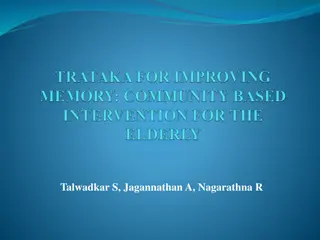Accommodating Employees with Diverse Cognitive and Neurological Needs - Training Overview
Explore the complexities of accommodating cognitive and neurological disabilities in the workplace, such as mental health conditions, ADHD, brain injuries, and seizure disorders. Learn effective solutions for maintaining productive employees with diverse needs in this informative session.
Download Presentation

Please find below an Image/Link to download the presentation.
The content on the website is provided AS IS for your information and personal use only. It may not be sold, licensed, or shared on other websites without obtaining consent from the author. Download presentation by click this link. If you encounter any issues during the download, it is possible that the publisher has removed the file from their server.
E N D
Presentation Transcript
Accommodating Employees with Diverse Cognitive and Neurological Needs April 11, 2024 Melanie Whetzel, Principal Consultant, Cognitive/Neurological Team Lead AskJAN.org JAN is a service of the U.S. Department of Labor s Office of Disability Employment Policy/ODEP.
2 Training Overview Accommodating Employees with Diverse Cognitive and Neurological Needs 04/11/2024 Accommodating cognitive and neurological disabilities, such as mental health conditions, attention deficit/hyperactivity disorder, brain injury and seizure disorders, in the workplace may pose unique considerations that do not exist with other disabilities, as the need for accommodations may not always be apparent. Potential complexities may arise in understanding employee limitations, identifying the root causes, and determining effective accommodations. Employers may encounter scenarios involving medical documentation, applying performance and conduct standards, ensuring safety, preserving confidentiality, and more. Join us for a session that explores complex accommodation scenarios in the workplace and discover effective solutions to help maintain productive employees with diverse needs. 60 minutes
3 Housekeeping Technical Difficulties Captioning PPT Slides Questions FAQ: JAN Webcasts Use the Q&A feature, Live Chat at AskJAN.org, or email Training@AskJAN.org FAQ: JAN Webcasts Use the closed caption (CC) feature or captioning link in chat Link included in webcast login email and in the chat, or go to this webcast event from the Training page at AskJAN.org Use the Q&A feature
4 Agenda Performance & Conduct Safety & Direct Threat Preserving Confidentiality Leave Communication Medical Documentation Q & A
5 Mental Health: Common Limitations Panic Memory Learning Attendance Organization Concentration Time management Sleep disturbances Working effectively Coworker interaction Stress/emotions management
6 Performance and Conduct Standards Americans with Disabilities Act (ADA): Performance Standards: Should be uniformly applied to all employees Do not have to lower as an accommodation Must consider accommodations Conduct Standards: Should be uniformly applied to all employees If employee with disability cannot comply, must be job-related and consistent with business necessity Must consider accommodations The ADA: Applying Performance and Conduct Standards to Employees with Disabilities
7 Performance Examples Pat s employer requests a meeting to talk about some recent performance issues. Pat is surprised. They didn t realize their performance was as low as the employer is stating. Jack, an employee who worked for an online catalog retailer, was having difficulty with serving customers over the phone and asked for a reassignment to a position where he did not have to talk to people but could do online chats and emails.
8 Conduct Examples After a few uncharacteristic outbursts, Jai rigged up makeshift partitions out of mailing boxes around his centrally located desk. His supervisor determined it was time to speak with him about his actions. Al is extremely upset because his employer has written him up for being late. His next occurrence will result in termination.
9 Ensuring Safety/Direct Threat An employer may require as a qualification standard that an individual not pose a "direct threat" to the health or safety of the individual or others, if this standard is applied to all applicants for a particular job. However, an employer must meet very specific and stringent requirements under the ADA to establish that such a "direct threat" exists. The employer must be prepared to show that there is: significant risk of substantial harm; the specific risk must be identified; it must be a current risk, not one that is speculative or remote; the assessment of risk must be based on objective medical or other factual evidence regarding a particular individual; and even if a genuine significant risk of substantial harm exists, the employer must consider whether the risk can be eliminated or reduced below the level of a "direct threat" by reasonable accommodation. Technical Assistance Manual for Title I of the ADA
10 Safety/Direct Threat Examples An employee disclosed that he had PTSD and asked for an accommodation of being allowed to leave his workspace and take a walk around the building if he was feeling particularly stressed. A maintenance employee with an intellectual disability and difficulty reading works alone and must be able to mix chemicals for the extermination of bugs
11 Preserving Confidentiality All medical information should be treated the same, regardless of how it was obtained (during post-offer examinations, voluntary disclosure, etc.). It should be kept in a file separate from the employee s personnel file and in a location that is accessible only to authorized personnel. Generally, only human resources personnel are entitled to the medical information, however, the Equal Employment Opportunity Commission identifies a few exceptions, which are as follows: Supervisors and managers may be informed about necessary restrictions on the work or duties of an employee and necessary accommodations. First aid and safety personnel may be informed, when appropriate, if the disability might require emergency treatment or if any specific procedures are needed in the case of fire or other evacuations. Confidentiality of Medical Information under the ADA Technical Assistance Manual for Title I of the ADA
12 Confidentiality Examples An employee on the spectrum asks her employer to provide disability awareness training to help coworkers understand her way of thinking and how she functions. An employer agrees to allow an employee to remain working at home 100% due to disability when others are required to return to a strict hybrid schedule. Coworkers are upset when they find out and demand to know what is going on.
13 Leave Leave is often misunderstood as an accommodation Difficulties for the employer include: Unscheduled leave Indefinite leave Leave after FMLA Hardship related to leave ADA Leave Beyond FMLA Employer-Provided Leave and the Americans with Disabilities Act Applying Performance and Conduct Standards to Employees with Disabilities Enforcement Guidance on Reasonable Accommodation and Undue Hardship under the ADA
14 Leave Examples An employee discloses depression and provides medical documentation that she will need intermittent time off. Her employer agrees to the two days per month likely needed but questions the employee and asks for new documentation as time goes on when she begins to miss two days per week and often comes in late and leaves early with no advanced notification. An employee scheduled to return to work after 8 weeks off for mental health calls in the night before and says she has had a relapse and cannot work. She submits documentation for another month. At the end of that month, the employee submits another request for three more weeks.
15 Communication Instructions in writing No in-person communications with coworkers or supervisor No contact at all with/change in supervisor No phone calls with clients/essential functions Modified schedule to avoid in-person contacts 100% telework Enforcement Guidance on Reasonable Accommodation and Undue Hardship under the ADA Q #33 Issues with Supervisor Difficulties Assisting on the Phone
16 Communication Examples Ric, a customer service representative, asked to be excused from talking to people on the phone because they exacerbate his anxiety Due to communication issues related to her disability, an employee had difficulty getting along with her supervisor and requested a reassignment.
17 Medical Documentation From whom? How much? When? How often? Medical Exams and Inquiries A Flexible Approach to ADA Medical Documentation Recertifying the Ongoing Need for Accommodation The Mental Health Provider's Role in a Client's Request for a Reasonable Accommodation at Work Q #9
18 Documentation Examples An employee develops panic attacks and asks her employer if she can take leave. When she tells her employer she s having trouble getting in to see a doctor, the employer tells her she can t take leave until she provides documentation. A newly hired employee drives children to and from appointments. After a seizure in the workplace, the employer reassigns the employee temporarily and asks for documentation. A doctor mandates telework or work in a limited commute area due to an employee s anxiety.
19 #MentalHealthAtWork Whether you re a CEO, worker, manager, supervisor or someone with a mental health condition, we ALL have a role to play to ensure a mental health- friendly workplace. That s the message behind the Mental Health at Work: What Can I Do? PSA. Campaign for Disability Employment (CDE) What Can I Do? PSA
20 JAN and EEOC Resources Accommodation and Compliance: Mental Health Conditions (JAN) A to Z of Disabilities and Accommodations The ADA: Applying Performance and Conduct Standards to Employees with Disabilities (EEOC) Enforcement Guidance on Reasonable Accommodation and Undue Hardship under the ADA (EEOC)
21 Questions? Use the Q&A Feature
22 Next JAN Webcast Ask JAN! Q&A: Cognitive/Neurological Team Edition May 9, 2024 Training Information AskJAN.org/Events/Training.cfm
23 AskJAN.org 800.526.7234 Ask JAN! We can help. Live Chat @ AskJAN.org Email JAN@AskJAN.org
24 Job Accommodation Network Social Media Job Accommodation Network JANatJAN JANinformation
25 Thank you for attending! Please complete the webcast evaluation 1 HR Certification Institute CEU is available after attending the live webcast (04/11/2024)























